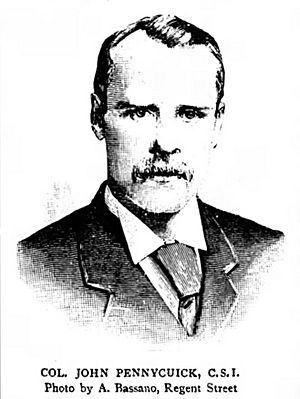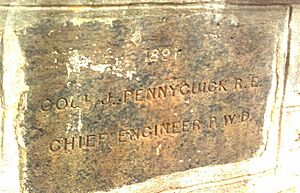John Pennycuick (engineer) facts for kids
Quick facts for kids
John Pennycuick
|
|
|---|---|
 |
|
| Born | 15 January 1841 |
| Died | 9 March 1911 (aged 70) London
|
Colonel John Pennycuick was a British Army engineer and government worker. He was known for building many irrigation projects, especially the masonry dam of Mullaperiyar on the Periyar River in India. This dam helped bring water to many dry farms.
Contents
Early Life
John Pennycuick was born on January 15, 1841, in Pune, India. His father, also named John Pennycuick, was a Brigadier-General in the army. Sadly, both his father and his oldest brother, Alexander, died in a battle in 1849. John Pennycuick went to school at Cheltenham College.
Career Highlights
Pennycuick joined the East India Company Military College in 1857. He became a lieutenant in the Madras Engineer Group in 1858 and arrived in India in 1860. He helped with a military campaign in Abyssinia in 1868 and received a medal for his efforts.
Later, he worked in the Public Works Department (PWD). This department is in charge of building and maintaining public structures like roads and dams. He became the Chief Engineer for the important Mullaperiyar Dam project. In 1895, he was given a special award called the Order of the Star of India by the Queen.
Pennycuick also served in the Madras Legislative Council, which was like a local government body. He was also the last president of the Royal Indian Engineering College. He even advised the Government of Australia on how to prevent floods in the Brisbane River. Besides his engineering work, he was also a keen cricketer.
Building the Mullaperiyar Dam
The Mullaperiyar Dam was one of John Pennycuick's biggest achievements. He had a bold idea: to change the direction of the Periyar river. This river flowed west towards the Arabian Sea. Pennycuick wanted to divert its water to the east. This would help water hundreds of thousands of acres of dry land that depended only on the Vaigai river.
Building the dam was extremely difficult. The workers faced dangerous diseases, many insects, and powerful storms. A severe flood even destroyed many sandbags that were ready for construction. The British government did not give enough money for the project. So, Pennycuick took a big step. He went to England and sold his own family property to get the money needed to finish the dam.
The dam was completed in 1895. It was opened by Lord Wenlock, who was the Governor of the Madras Presidency at the time. Thanks to the dam, about 223,000 acres of land in districts like Theni, Dindigul, and Madurai could now be irrigated.
Pennycuick used a special mix of lime and surkhi paste for the dam's construction. This made the dam very strong and able to withstand tremors. Pennycuick once said, "I am going to be only once in this earthly world, hence I need to do some good deeds here. This deed should not be prorogue nor ignored since I am not going to be here again." This shows how dedicated he was to his work.
Death
John Pennycuick passed away in Camberley, England, on March 9, 1911. He was buried in the Churchyard of St. Peter's Church in Frimley. In 2018, his grave was updated with a large granite plaque. This plaque was a gift from the states of Tamil Nadu and Kerala in India, showing their thanks for his amazing work on the Mullaiperiyar Dam.
Family Life
John Pennycuick married Grace Georgina Chamier in 1879. Their son, Sir John Pennycuick, grew up to become a respected English lawyer and High Court judge.
How He Is Remembered
John Pennycuick is still greatly admired, especially by the farmers in the areas that benefit from the Mullaperiyar Dam.
- The Public Works Department Office in Madurai has a life-size bronze statue of Pennycuick. The entire PWD complex there is named after him.
- There are four statues of Pennycuick on PWD properties, including one at the Periyar dam itself.
- Farmers in some areas celebrate his birthday by unveiling granite portraits and sharing sweets.
- A memorial for Pennycuick was opened in January 2013 in Theni district.
- A new bus terminus in Theni was named after him in December 2013.
- During the traditional Thai Pongal harvest festival, people in places like Veerapandi and Balarpatti remember Pennycuick.
- Many children in the region are named after him.
- Some farmer families in Theni and Madurai districts still keep pictures of Pennycuick in their homes. They honor him like a god, offering prayers and garlands to his portraits.
- A white marble bust of Pennycuick was given to his family by the Commissioner of Police, Greater Chennai Police. This bust was unveiled at St Peter's Church in Frimley in 2019.
- Another bust, donated from Tamil Nadu, is planned to be installed in Camberley in 2022.


